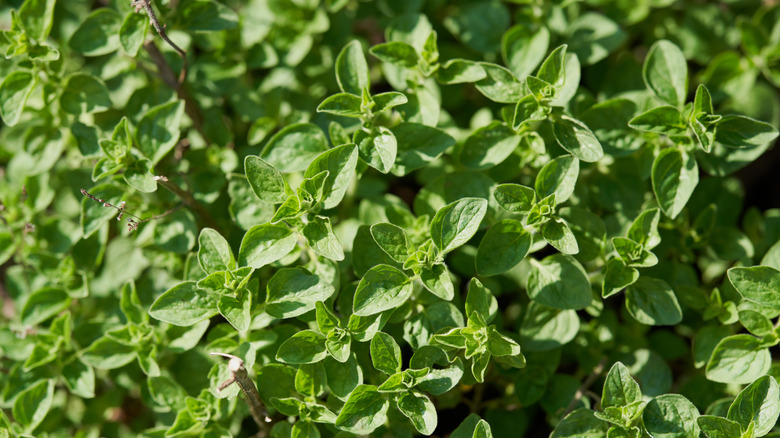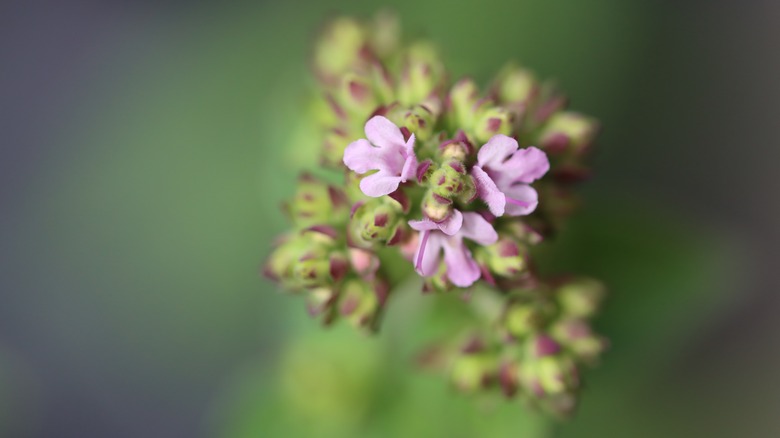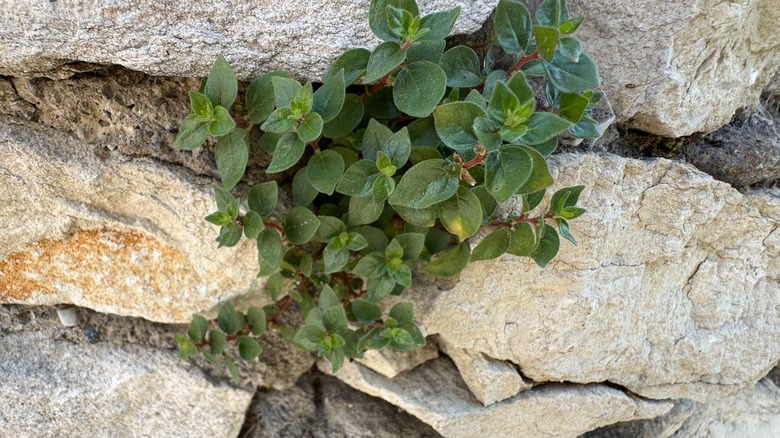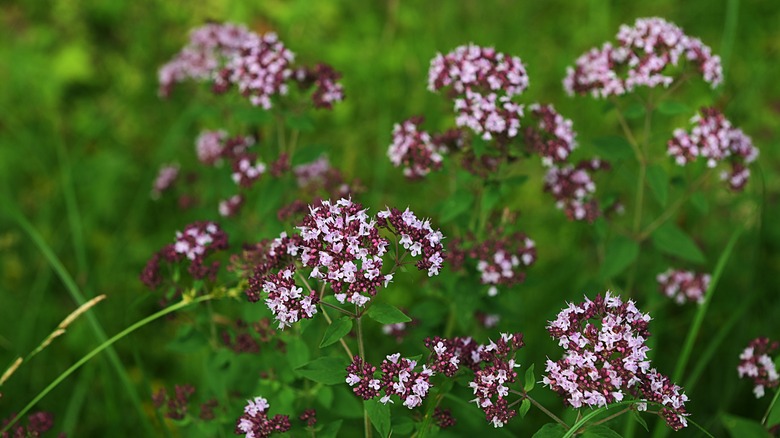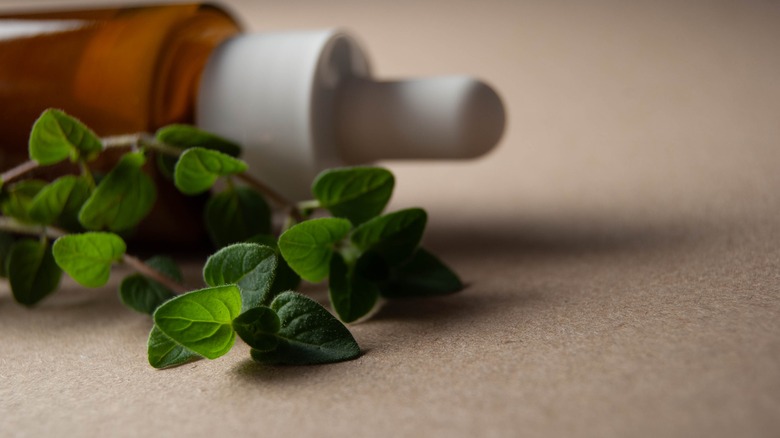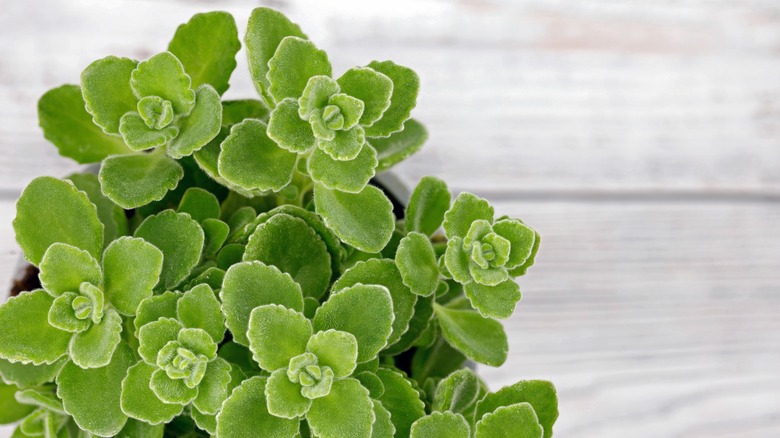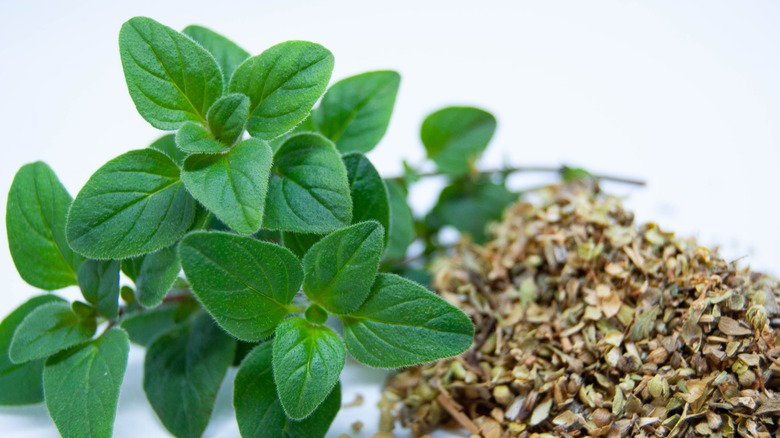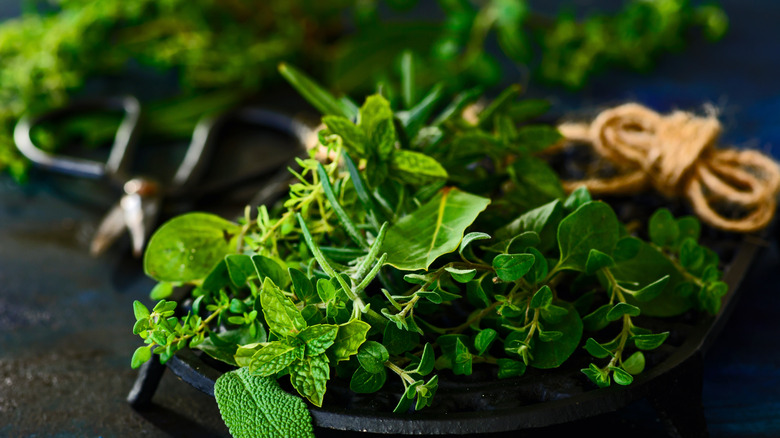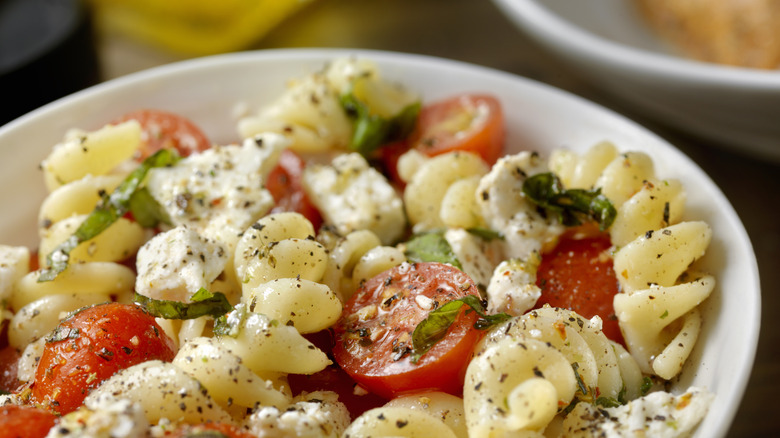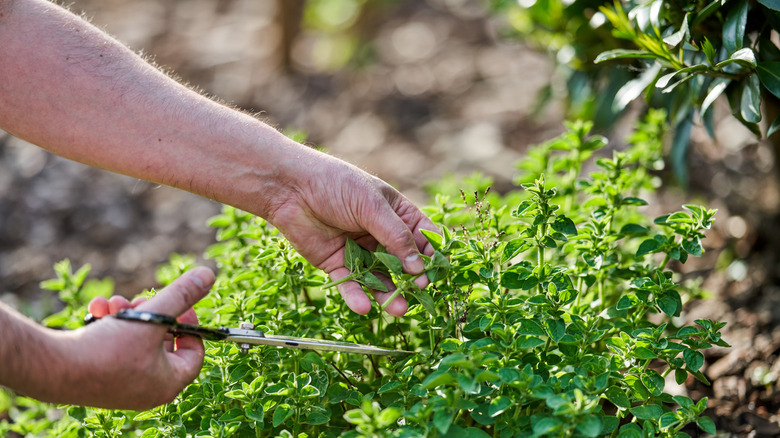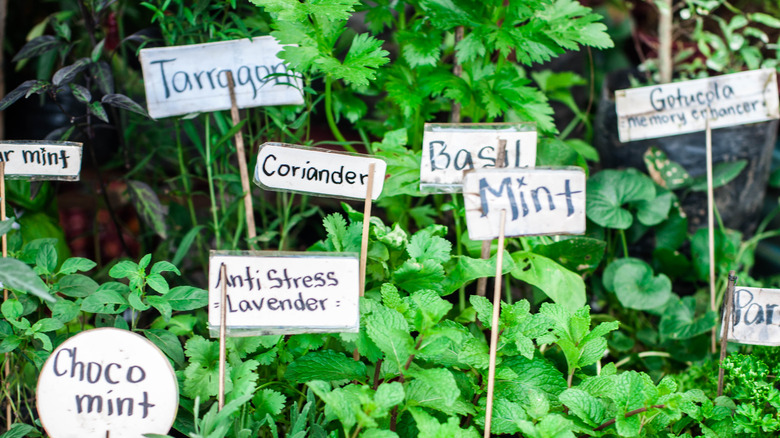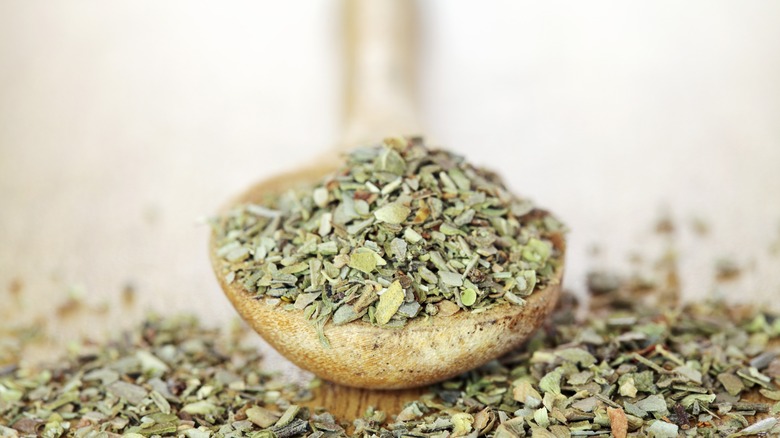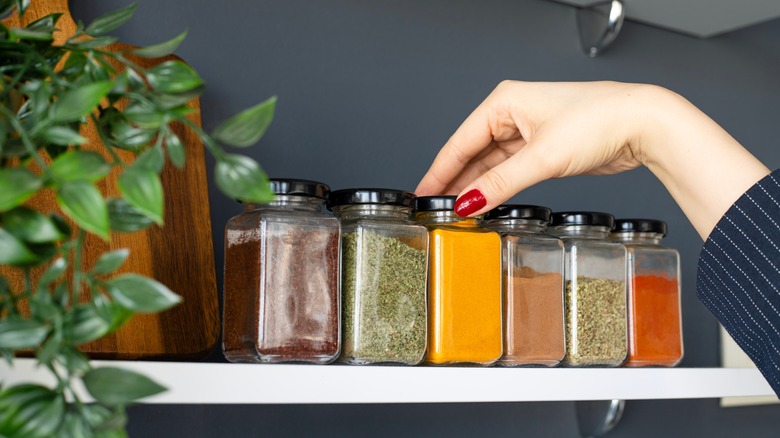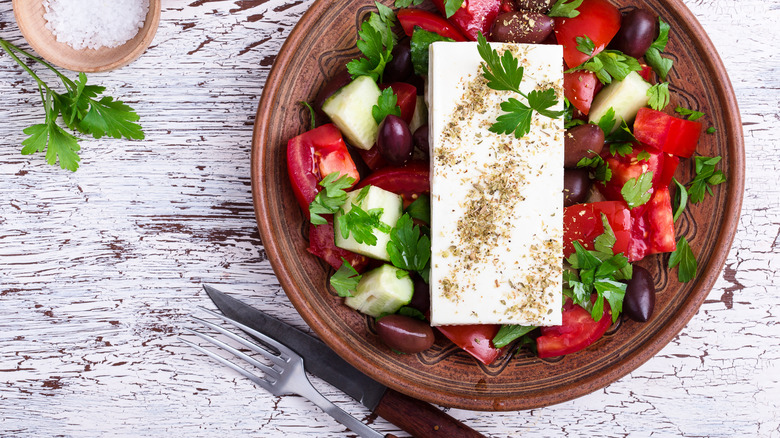Your Guide To Every Type Of Oregano
We may receive a commission on purchases made from links.
Oregano is one of the most common herbs in a range of European, African, and Latin cuisines. It is pungent, a bit spicy, and inimitable, and can be used in all kinds of ways in the kitchen. It consistently makes Best Herbs lists on pretty much every food blog, yet many people don't understand its potential.
Also, many culinary enthusiasts are missing out on the potential of Mexican and Cuban oregano, less well-known cousins of the more common variety. These offer many of the same benefits of traditional Mediterranean oregano, looking darling in both pots and the yard, depending on your climate. In other words? It's a spice to grow, to cook with, to love.
To help you do that, Chowhound looked at the most common types of oregano, its history, and the best ways to use it, all of which you'll see here. You'll also learn how to choose it, store it, and cook with it for maximum flavor, as well as the health benefits you can expect when adding it to your kitchen repertoire.
What is oregano?
Oregano (Origanum vulgare) is a perennial herb belonging to the mint family (Lamiaceae), close cousins of familiar kitchen denizens such as thyme, lavender, and sage ... and, of course, mint itself. It is native to the Mediterranean and Western Asia, though it grows in home gardens all over the world today. The leaves are used in cooking, while the tough stems are discarded.
Oregano flowers range in color from white to pink to purple, usually with five petals. Although there are many different cultivars of oregano, they all come from the same family (not counting Cuban and Mexican varieties, discussed below). Common oregano grows to about three feet tall and two feet wide, though it will maintain a more compact habit if you prune it regularly. Other species vary in their growth habits, but they share the same woody structure and aromatic leaves.
A brief history of oregano
Oregano is a storied herb that once grew wild on rocky landscapes around the Mediterranean and farther east. Its name stems from the Greek words for mountain (oros) and joy (ganos), presumably because folks were happy to stumble across it on the hillsides of Ancient Greece. (This writer certainly would have been, which is why she grows many varieties abundantly in her garden.) It is said to have been created by Aphrodite, is a symbol of happiness, and was historically used in wedding decorations. But it wasn't just happiness the Greeks got out of it; they and their Roman counterparts both used it medicinally as well.
Although oregano came to Latin America along with Spanish colonists, it was not popular in the United States until after WWII. During the war, GIs developed a taste for oregano and helped introduce it to a wider American audience after the war. Today, Americans consume upwards of 14 million pounds per year, which is a frankly mind-boggling amount of vegetable matter.
Oregano in global cuisine
Given the vast quantities people consume in the United States alone, it's no surprise that oregano has become popular around the world. While most people think of it as accompanying lamb in Greek cuisine or pasta sauce in Italian fare, it has a much wider wingspan than that. From the Mediterranean to South America, Europe to North America, it's pretty much everywhere at this point.
Indeed, it is one of the most cosmopolitan herbs there is, important in Middle Eastern and Turkish, North African, and French cooking, and that's just scratching the surface. It also has an important role to play in many spice blends. Though it is not traditionally thought of as a common spice in the culinary palettes of Asia, it goes well with traditional flavors, such as lemongrass, garlic, and ginger.
The flavor of oregano
Oregano is herbaceous, earthy, and a bit spicy. It also has bitter and minty notes, with a hint of mustiness and hay. This is due to the combination of its various essential oils, the most common of which are pinene, limonene, thymol, and carvacrol. Its flavor profile makes it especially well-suited to the Greek culinary palette, which relies heavily on lemon, olive oil, and oregano as a base for many dishes. Despite all that, oregano leaves do have a nice sweetness to them, which especially comes out when dried.
Also, the flavors of oregano can vary depending on where it comes from. You have to be tricky when making these claims, since there are two ways the herb can differ: by type or by region. Herbs, like wine, are influenced by terroir, or the location in which they are grown, which can influence their flavor. So oregano grown in Turkey is astringent, while that from Greece is earthy and from Italy is mild. But the variety itself also matters, discussed next.
The most common varieties of oregano
When you buy oregano at the store, chances are you don't look at the exact species that was harvested to make up your fresh bunch or bottle of crumbled leaves. That's okay, but if you're growing it yourself or buying specialty blends, you might want to be more careful, because there are many types of oregano, both ornamental and culinary.
The main species (Origanum vulgare) is the most common one that people grow in home gardens and with which they cook. However, several other edible varieties exist. Well, technically all varieties are edible, but you might not want to eat some of them due to an unappetizing or boring flavor.
Ornamental varieties tend not to be as flavorful, so you won't find them in the store. That said, most people look for regular oregano (Origanum vulgare) to grow in the garden or get at the store. Runners-up include Italian oregano (a hybrid of common oregano and marjoram, itself a species of oregano) and pot marjoram (Origanum onites), aka Cretan or Turkish oregano.
Available forms of oregano
Oregano comes in a surprising number of forms, the most obvious of which are fresh (in the produce section) and dried (in the spice aisle). You can also get it as a dried whole leaf or in dried bundles online. If you're feeling extra fancy, you could try something like Sanniti Origano di Calabria Italian Dried Oregano on the Stem, which will bring the real flavors of Italy to your kitchen.
If you're looking to expand your options, herbalist shops and natural food stores often have essential oil (though you have to be careful when cooking with it). Depending on the cuisine, you may opt for a spice mix that contains oregano rather than using the herb straight, as it is an ingredient in many blends. From North Africa, we have ras el hanout, while from the Middle East, we have the popular spice blend za'atar. If you're not sure where to get it, you can try an online version such as Za'atar by Z&Z.
What's the deal with Cuban and Mexican oregano?
Complicating matters further is the fact that there are other types of "oregano," one from the mint family and one totally unrelated. Cuban oregano (Plectranthus amboinicus) is another member of the mint family, though it is not in the Origanum genus. Also known as Spanish thyme, it's widely used in the cuisines of warmer countries from India to Africa to the Caribbean. Adorable and fleshy, halfway between an herb and a succulent, it looks great in a pot on the front steps or in a sunny window. While it is hard to find dried, you can buy Cuban Oregano Seeds online.
While Mexican oregano (Lippia graveolens) is similar in aroma and flavor to both common and Cuban oregano, it is not a cousin of mint but is actually in the verbena family. Mexican oregano is fleshier, has different growing conditions, and is often used in Latin cuisine and Mexican food, as the name suggests. Its flavor is more earthy and citrusy, and you can enjoy it dried, such as in this Savory Spice Mexican Oregano.
To distinguish it from its more exotic cousins, what we call common oregano is sometimes referred to as Greek oregano, referring to its Mediterranean origins. Do note, though, that technically Greek oregano is its own cultivar, O. vulgare ssp. Hirtum, so this is not a proper term.
Dried versus fresh oregano in cooking
Fresh oregano has a very zingy, peppery flavor. Some cooks feel that it is too intense and can easily overpower other ingredients in a dish. To combat this tendency, you can use fresh oregano whole but remove it from the dish before serving. (For instance, you could place oregano in the cavity of a fish or chicken.) Others prefer to infuse oregano into oil, either cold or hot, to leach out the flavor but keep it mild. Oregano is a bit of a rarity in that its dried form is often less pungent and easier to use than fresh.
You can easily buy dried oregano online. And, believe it or not, you can also get the fresh version delivered right to your front door, such as Fresh Green Organics Oregano. Either way, make sure your herbs are within their expiration or best-by windows and come from a reputable company.
How to choose the best herbs
If you're looking to add fresh flavor to your cooking, herbs are the way to go. As discussed, oregano is unique in that many people prefer its dried form to just picked, but it is unquestionably delicious if you get fresh leaves and use them right. When you're choosing fresh herbs, make sure they have strong stems, are nice and springy, and smell the way they're supposed to. Discard any that look dried out, brown or yellow, or dull.
If you're choosing dried, check the expiration date, look for a reputable brand, and make sure the herbs within look nice and green rather than gray. Even though they're dried, they should have color. If they have a faded pallor, they most likely won't give you the flavor results you're looking for. Bulk-dried herbs may be an even better bet since they turn their inventory over more regularly and thus were likely harvested and supplied more recently than what you would find in a small jar.
Common uses for oregano in the kitchen
There's so much you can do with oregano. It goes well in mains and sides, rubs, and marinades such as salmoriglio, which is an effortless way to tenderize steak. With its pungent, spicy flavor, it's a wonderful accompaniment to chicken and fish, and it gives your all-purpose tomato sauce an amazing depth of flavor. Try it on garlic bread, in meatballs, and in minestrone soup.
You can use the fresh leaves as a garnish, chiffonade them to scatter over pizza for flavor, or use them minced finely as the base for a zingy salad dressing. When using dried herbs, you can sprinkle oregano right into the dish or grind it up with a mortar and pestle to make a nice, easily blended powder, perfect for incorporating into smooth sauces or mixing with other spices.
Oregano even has its place in sweets and cocktails. It's a lovely addition to a Paloma, that classic drink of tequila, grapefruit juice, and simple syrup. It will also give your next Bloody Mary a fresh, spicy twist. As for dessert, try a shortcake with lemon and blueberries, blueberry oregano compote, or spicy oregano sugar cookies.
Growing and drying your own oregano
Oregano is a hardy garden companion, withstanding cruel winters and blistering drought equally well. It grows happily in USDA zones 4 through 8, and will thrive as an annual in colder or warmer locations. If you want to grow it for the kitchen, start with common oregano, which has a reliable aroma and flavor for cooking.
Many ornamental cultivars also exist. Though typically these aren't ideal for cooking, they are lovely, which is why some people choose to plant varieties such as Drops of Jupiter or Kent Beauty. And homesteaders take note: Drying herbs such as oregano is as easy as harvesting long stems, bundling them together, hanging them upside down, and harvesting the leaves when they're good and dry.
If you want to grow your own herbs from seeds, which is the cheapest way to go about it, you can try cute little 3.15-inch Peat Pots for starting seeds indoors. Or you can buy specimens from the nursery and pot them up in a set like this Barnyard Designs Indoor Herb Garden Planter.
Substituting for oregano
Sometimes you need the ol' oregano, but you just don't have it. If that happens, don't fret; there are several oregano alternatives that will work pretty well. Not only does oregano substitute well for basil, but basil can act as a surrogate for oregano too. The two herbs share a flavor profile: peppery when fresh, sweet and earthy when dry.
Even if you don't have basil, you still have options. Anything else in the mint family, including marjoram, sage, and thyme, all work well. (Word to the wise, though, lavender typically has strong floral overtones that don't substitute for its cousins super well.) Members of other families with similar flavor profiles include parsley and dill (both in the Apiaceae family) and tarragon (Asteraceae).
You can also substitute with spice blends that contain oregano, but be careful. A blend such as Herbes de Provence contains some bullying flavors, the main one being lavender, so make sure you're cooking with a European flavor palette. By the same token, ras el hanout and za'atar both have strong, obvious Middle Eastern and African profiles that will only play nicely with recipes that are already leaning in that direction.
Health benefits of oregano
Oregano is such a beneficial herb, helping to fight inflammation and relieve muscle aches, treating diarrhea and indigestion, offering antimicrobial and antiseptic properties, and even helping to heal skin sores.
Its health benefits also extend to the heart and nervous systems, and it may even help fight cancer. Extracts from the oregano plant have shown the potential to prevent damage to DNA inside cells, the main mechanism by which cancer arises, by fighting the damaging effects of radiation and oxidative stress. Also, oregano may help control mitogens, which can in turn regulate the division of cells.
These benefits may arise from eating oregano fresh or dried. However, oregano tea is said to have strong health benefits as well. It may help with cold symptoms, IBS, bloating, and edema. You can make it yourself, or you can buy it online in a premade blend, such as FullChea Oregano Tea Bags.
Storing oregano to last
The best ways to keep oregano fresh and flavorful depend on whether it is fresh or dry to begin with. The dried version lasts best in glass jars, as is the case when storing most spices. Keep it tightly sealed and in a cool, dark place. Even if you don't have a pantry or cupboard, try at least to keep it clear of the heat of the stove, strong sunlight, and moisture. If you like to grow and dry your own spices or make DIY spice blends, consider getting a set of Spice Jars with hinged lids. The rubber seal will help keep out water and contaminants that will shorten oregano's shelf life.
Typically, dried leaves like oregano will stay good for 1-2 years. Although they won't go bad in the sense that you can get sick, they may lose their flavor, thus eliminating their role in the kitchen.
Fresh oregano, while considered a hardy herb, still needs some TLC to remain viable in the fridge for as long as possible. Wash and dry it when you get it home, making sure you get all the moisture off before proceeding to the next steps. Then trim off the bottom half inch of the stem, roll the herbs in a lightly dampened paper towel, and stuff the entire bundle into a resealable bag. Store the whole thing in the fridge until ready to use, where it can stay good for up to three weeks.
Nutritional information
Oregano contains boatloads of vitamins and minerals, so wherever you can add it to your culinary endeavors, you should. For instance, it contains calcium, magnesium, iron, phosphorus, sodium, potassium, and selenium. It also boasts vitamins C, K, A, and E, as well as folate (aka vitamin B9) and other B vitamins. These types of compounds, as well as the synergistic links between them, are largely responsible for the health benefits of oregano.
Plus, oregano has almost no calories, so you can feel free to add it to whatever you want with little risk. Fresh oregano has 178 calories per cup, which translates to about four per teaspoon. Because it is concentrated during the drying process, dried oregano has a few more calories than fresh. It still only tops out at about six calories per teaspoon, however, which is hardly a concern when ranked with every other ingredient that will be in your dish.
